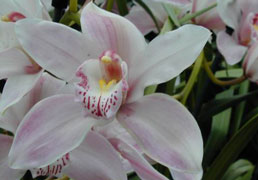


Home
Flowers &
Indoor Plants
Fruits & Nuts
Ornamentals
Vegetables
Special Topics
Resources
Glossary

 |
What about it? Orchids are a tropical species, which explains their high degree of complexity and ornamentation. Orchids come in 2 varieties: the epiphytic, or air growing forms, and the terrestrial, or land-growing forms. There are even some that look nearly identical to certain insect species. They belong to a family of plants with over 15,000 species. Some characteristics of this family are a thick root system, few leaves, and a distinctive irregular flower identified by the labellum, or lip-shaped petal. Three common genera are Cattleya, Cymbidium, and Phalaenopsis. What is it used for? Despite their complicated and exotic looks, orchids are relatively easy to grow, especially the Cattleyas and the Iaelias, otherwise known as the "corsage orchids". Because they are tropical plants, most do not survive in a temperate environment. However, they are extremely popular in florist's shops and can be grown indoors in green houses or pots. Exceptions are the lady's slipper orchids, which thrive in shady, moist settings outdoors. Where does it grow? How do we grow it? When growing orchids, always keep in mind their native environments and try to imitate it as well as possible. A tropical rainforest is typically very moist and humid and adequately shaded. Furthermore, the temperature does not fluctuate too much from day to night. Thus, orchids will do best in partial shade with plenty of humidity. Don't water the roots as much as you mist the leaves. They need good ventilation and a constant temperature no less than 65 degrees F. What are its primary problems? Orchids are commonly attacked by red spiders, thrips, snails, and scale. Viruses can also be troublesome. How do we propagate it? Orchids are propagated by division, cuttings, or seeds. It will take 4-8 years for a seedling to bloom, so be patient if this is your plan.
© Copyright, Department of Horticulture, Cornell University. |




